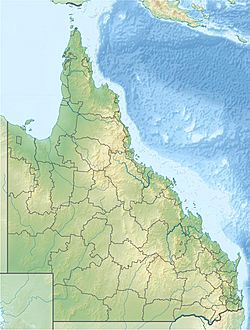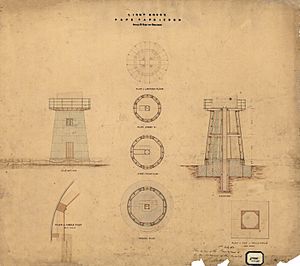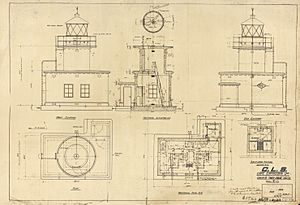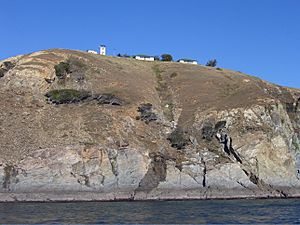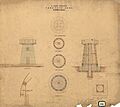Cape Capricorn Light facts for kids
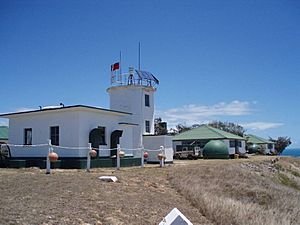 |
|
| Cape Capricorn Light, 2008 | |
|
|
|
| Location | Cape Capricorn Queensland Australia |
|---|---|
| Coordinates | 23°29′11.1″S 151°14′12.4″E / 23.486417°S 151.236778°E |
| Year first constructed | 1875 (first) 1936 (second) |
| Year first lit | 1964 (current) |
| Construction | concrete blocks |
| Tower shape | square prism chamfered corners tower with balcony and no lantern |
| Markings / pattern | white tower |
| Height | 23 feet (7.0 m) |
| Focal height | 305 feet (93 m) |
| Range | white: 16 nmi (30 km; 18 mi) red: 12 nmi (22 km; 14 mi) |
| Characteristic | Fl WR 5s |
| Admiralty number | K2992.1 |
| NGA number | 111-10336 |
| ARLHS number | AUS-026 |
The Cape Capricorn Light is an important lighthouse in Queensland, Australia. It stands on Cape Capricorn, which is a point of land on the northeast side of Curtis Island. This lighthouse helps ships find their way near the city of Gladstone. The lighthouse you see today was built in 1964. It's actually the third lighthouse to stand in this spot! The first one was made of timber in 1875, and the second was made of concrete around 1937. This historic lighthouse was added to the Queensland Heritage Register in 2001.
Contents
History of the Cape Capricorn Light
The First Lighthouse (1875)
Back in 1859, Queensland became its own separate colony, no longer part of New South Wales. Ships needed help to get into the Fitzroy River and reach the port of Rockhampton. So, a special station for pilots (people who guide ships) was set up on Curtis Island in 1861. Even though this station moved later, everyone agreed that a lighthouse was still needed at Cape Capricorn.
Plans for the first lighthouse and homes for the keepers were drawn up in 1874. The lighthouse was designed to be made of timber and iron. It was built in Brisbane and then moved to Cape Capricorn. The construction was finished in October 1874. However, there was a mix-up, and the lamp room (where the light goes) wasn't ordered! An urgent request was made to build a lamp room from timber and iron. The lighthouse finally started working in July 1875. It used an oil lamp to create its light. By 1895, there were also two smaller lights nearby to help guide ships.
Getting supplies to the lighthouse was very hard. Supplies came by steamboat to the bottom of the hill. Then, they had to be pulled up over 91 metres using a tramway and a winch. In 1912, it was suggested that the light should be made stronger. Also, the homes and tramway needed repairs. In 1915, the lighthouse became controlled by the Australian government. It took eight more years, until 1923, for the light to be updated. It was changed to a brighter kerosene lamp. In 1936, there were plans to make the light electric. But that same year, it was decided to replace the whole lighthouse tower instead.
The Second Lighthouse (1938)
In 1936, the government decided to build a new lighthouse made of concrete blocks. Plans for this new tower were ready in September 1937.
This new tower was 6 metres (about 20 feet) tall and square-shaped. It had a power station built right next to it. At the top, there was a round balcony and a small round lantern room. The homes and other buildings were also replaced with new ones made of timber and asbestos. The second lighthouse started working with electric power in 1938. However, for reasons we don't know, this lighthouse didn't last very long. It was replaced just 26 years later, in 1964.
The Third Lighthouse (1964)
Plans for a new power station and lighthouse were made in 1962 and 1963. By 1964, the new lighthouse was finished and its light was working. This lighthouse was one of the first of seven new concrete towers built in Queensland between 1964 and 1979. Other lighthouses like New Caloundra Light and Point Danger Light were built after this one. In 1968, the light was updated to use 240 Volt electricity.
From when it was built until 1978, the Cape Capricorn lighthouse was very important. It was the main radio station for other lighthouses nearby, including North Reef Light and Lady Elliot Island Light. In 1978, this job was given to the Bustard Head Light.
In 1983, a report suggested that 24 lighthouses, including Cape Capricorn, should no longer have keepers living there. In 1988, the Cape Capricorn station was finally changed to use solar power, and the keepers likely left. The old lantern was removed, and a new, self-contained light was put in its place. The ownership of the station changed a few times. Now, the Queensland Government owns it and has a caretaker living in one of the homes. Other homes are rented out to people.
What the Light Shows Now
The light at Cape Capricorn flashes once every five seconds. It can show white or red, depending on which direction you are looking from. The white light can be seen for about 16 nautical miles. The red light can be seen for about 12 nautical miles. The light uses a 120 Volt halogen lamp, which gets its power from diesel generators.
Buildings at the Site
The lighthouse tower you see today is 6.4 metres (about 21 feet) tall. It's made of concrete blocks and has a square shape with angled corners. There's a small porch at the bottom. A round balcony with a metal railing sticks out from the top of the tower. The modern light beacon is placed on top of this balcony.
The lighthouse keepers' homes include two cottages. They are made of timber and covered with asbestos cement sheets, painted white. Their roofs are green and made of corrugated iron. Other buildings on the site, built in a similar way, include a store, the old power station, and a winch house. These are all built on tall concrete foundations. The newer power station, built in 1964, is made of white concrete blocks. It has a large main room and a porch with flat concrete roofs. There are also other smaller sheds on the site, mostly made of timber with corrugated iron walls and roofs.
You can still see the old rail line, which is a concrete path with steel rails that goes down to the beach. It has a timber trolley on a metal base, a metal rope, a winch, and a motor. There is also a concrete helipad nearby for helicopters.
Some old parts of the previous lighthouses can still be found in a valley north of the station.
Visiting the Lighthouse

The light itself is managed by the Australian Maritime Safety Authority. The site where the lighthouse stands is managed by the Queensland Parks and Wildlife Service, as it's part of the Curtis Island National Park. You can only get to the island by boat or helicopter. The lighthouse tower is not open to the public. However, you can stay overnight at the site, as there are two homesteads and two cabins available for accommodation. The original lens that was used in the lighthouse is now on display at the Townsville Maritime Museum.
Images for kids
-
Lenses on display at Townsville Maritime Museum, Cape Capricorn's original lens on the top right


